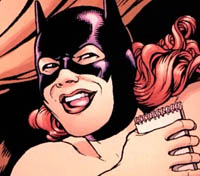
Who Will Be Shocked By The Watchmen?
August 27th, 2008 Posted by Esther Inglis-ArkellWatchmen will be coming out in March and, no doubt, the first few screenings will be almost entirely packed with comic book fans. The book, to comics fans, has a status somewhere between The Catcher in the Rye and the moon landing. It not only changed their lives, it marked a turning point for comics in general, taking a more critical and nuanced look not only at superhero characters, but at the concept of superheroes in general. Alan Moore presented a deeply cynical vision at the way the world would look if it had to interact with a group of dangerously powerful people with big egos and flexible morals. The book made every fan who ever fantasized about the fourth wall dissolving consider that it might turn the world darker and more dangerous rather than more exciting and fun. Watchmen wasn’t a book, it was an event, and so I’m guessing that the first few screenings will alternate between awed silence and wild cheering.
What about the screening after that? If the movie had come out a year or two after the novel’s publication, it would have knocked the socks off of people whose standard for superhero movies was Superman IV: The Quest for Peace, but will today’s audiences be aware of it as anything more than another film that is ‘based on a graphic novel?’
The color scheme is from The Dark Knight and 300. The sense of the alienation of powerful beings from everyday people is from Superman Returns. The idea of a superhero as something the public is afraid of is in movies from Hancock to The Hulk.
As for the public being right to fear superheroes, even Peter Parker turned to the dark side for a while, and he was played by Tobey Maguire. From outright immoral supers, like the ones in Wanted, to the heroes of Sin City, who had the welfare of the downtrodden at heart, but whose skills tended towards being able to quickly dispose of bodies, to the neurotics of superheroes being milked for comedic value in My Super Ex-Girlfriend, to Batman, one of the most straight laced of superheroes, being tangentially involved in the deaths of super villains, it’s more difficult to find a superhero movie in which the superheroes are unquestionably good than it is to find one that looks at them through more jaundiced eyes.
I’m not saying that Watchmen shouldn’t be made or that it has nothing to contribute. That would be like arguing against the filming of an Elmore Leonard story because the world already has enough heist movies. If anything Watchmen deserves more acclaim for originality, since it was one of the books that pioneered the more skeptical view of superheroes that has become the standard.
However, there is no denying that that view has become the standard. It’s odd that the innovation and influence of Watchmen in the medium of comics will probably lessen its impact when it becomes a film. Success has a price.



